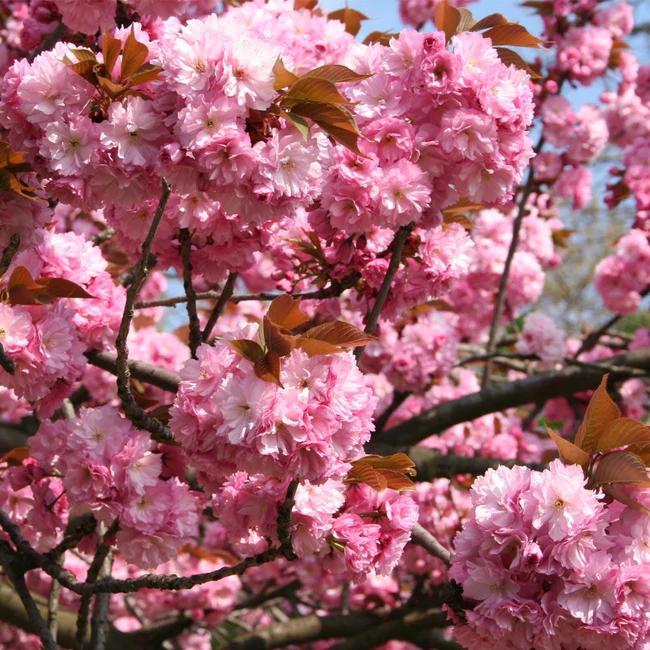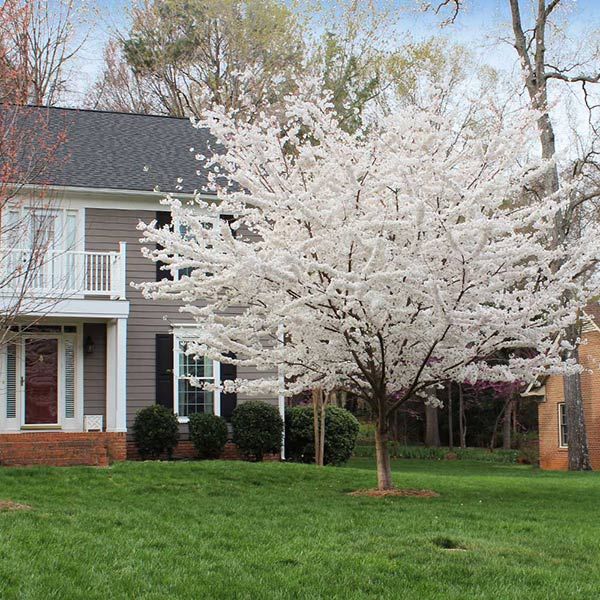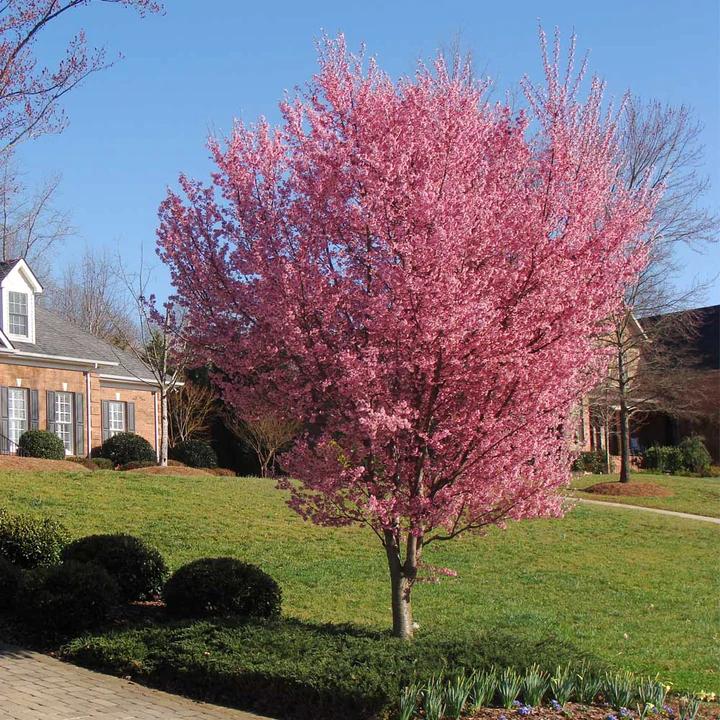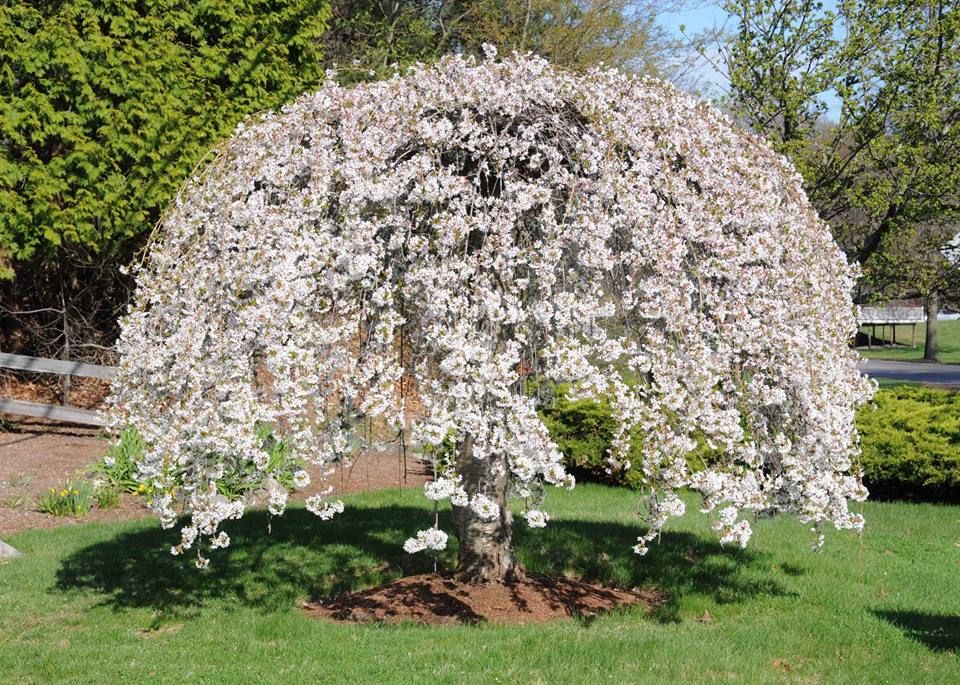6 Favorite Cherry Blossom Trees & Why We Love Them
By Axis Fuksman-Kumpa • July 10, 2023

There’s no more iconic flowering tree than a cherry blossom tree. Tourists flock from all over the world to see Japan’s famous cherry trees laden with pink cherry tree blossoms (called sakura in Japanese) every spring. Their flowers are delicate, fragrant, and thoroughly magical when the petals start to rain down in swirling clouds of pastel pink. Thankfully, you don’t have to cross the globe to enjoy that wonder—you can grow a Japanese cherry blossom tree right in your own yard.
Today, there are hundreds of varieties of flowering cherry trees that vary in size, shape, bloom color, and hardiness. That means that wherever you are, you can almost certainly find a perfect cherry blossom tree for your landscape. We love to use these beautiful trees in our designs, and we’ve collected a list of our favorite cherry tree varieties to help you find the perfect one (or several!) for your home.
What Makes Cherry Blossom Trees Special?
The soft pink of cherry blossoms is one of the earliest harbingers of spring as color returns to your landscape after a long winter. These early spring flowering trees are beautiful when in bloom, but also verdant green in the summer, awash with colorful leaves in the fall, and striking even in winter as their branches grow into impressive sculptural features with age.
The many varieties of cherry trees now include dwarf trees for small spaces and cascading weeping cherry trees, as well as an expanded color palette of blooms that can be white, pale pink, or bright saturated pink. The foliage colors in fall can be vibrant red, orange, yellow, and purple. Some varieties even have colorful bark to add visual interest to every part of the tree. Ornamental cherry trees don’t produce the kind of sweet cherries we buy at the grocery store, but most do produce tart and sour cherries that will be a buffet for wild birds.
Best of all, cherry trees are relatively low maintenance and a versatile landscaping plant. They shine as a single focal point tree, with pairs framing a door or driveway, or even in a small grove for maximum color and flowers in the spring. If you pick a variety that’s hardy in your climate, it’s hard to go wrong—and with the many types available, you’re sure to find a cherry tree that’s right for you.
Our Top Cherry Blossom Tree Varieties
Weeping Cherry Tree
Weeping cherries bring together the delicate blossoms of a classic cherry tree with the dramatic sweeping boughs of a weeping willow to create a beautiful and elegant cherry tree. There are many cultivars of weeping cherry that feature single or double pink or white flowers and even dwarf varieties for small spaces.
The weeping cherry will thrive in most temperate climates with just some well-draining soil and annual fertilizing. They may require slightly more pruning than other cherry varieties because they are a grafted tree. This means that the top of the tree produces the weeping branches you want, while the bottom is a different variety used as rootstock. Any branches growing off the base should be pruned to maintain the tree’s appearance.
- Mature height: 15-25 ft.
- Mature width: 15-25 ft.
- Sunlight: Full sun
- Hardiness zones: 5-8

Kwanzan Cherry Tree
It’s difficult to beat the Kwanzan flowering cherry when it comes to sheer volume of flowers! Its branches are laden with bold clusters of pink flowers each spring, and their blooms can last for weeks. This colorful statement piece makes an ideal focal point tree anywhere you’re looking for an explosion of pink that will give way to stunning golden leaves in the fall.
Kwanzan cherries are quite hardy and can tolerate a wide range of climates. They reach an impressive height, and given time, they’ll become a showstopping feature of your landscape.
- Mature height: 30-40 ft.
- Mature width: 30-40 ft.
- Sunlight: Full sun
- Hardiness zones: 5-9

Yoshino Cherry Tree
The stunning white flowers of the Yoshino cherry tree have a starring role in Washington, D.C.’s National Cherry Blossom Festival for a very good reason! The abundance of fluffy white blooms makes these statuesque trees look almost like a cloud has floated down out of the sky and they will introduce that same romantic appearance into your yard.
The Yoshino cherry can thrive in most soil types and requires minimal care beyond annual fertilizer and occasional watering if they become dry between rains. Their full height will tower above most of your plants and become a beautiful centerpiece of your landscape.
- Mature height: 40-50 ft.
- Mature width: 25-40 ft.
- Sunlight: Full to partial sun
- Hardiness zones: 5-8

Okame Cherry Tree
The colorful Okame cherry blooms so early that its branches will often be decked with pink flowers before its leaves even appear. This tree is all about blooms, blooms, blooms with clusters of large, fragrant, deep pink flowers—and each single petal can be an inch wide! In autumn, the leaves turn to a fiery range of red, orange, and yellow.
Okame cherries will flourish in well-draining soil with regular application of nitrogen-rich fertilizer. Prune away fading fruits and flowers to encourage healthy growth next season, and you’ll be rewarded with a striking and colorful tree for years to come.
- Mature height: 20-30 ft.
- Mature width: 20-30 ft.
- Sunlight: Full sun
- Hardiness zones: 6-9

Snow Fountain Cherry Tree
This miniature relative of the full-size weeping cherry offers a fountain of beautiful white blooms that can be neatly tucked into any gaps in your landscape. They are beautiful as focal point or accent trees, and their small size makes them the perfect choice to frame a building or walkway because they won’t overgrow their space. After their blooms are gone, snow fountain cherries show off gold and orange fall foliage and rich mahogany-hued bark year round.
These hearty little trees are cold hardy and heat resistant. Between their beauty, adaptability, and petite size, it’s easy to find a place for them in almost any landscape design.
- Mature height: 8-15 ft.
- Mature width: 6-8 ft.
- Sunlight: Full sun
- Hardiness zones: 5-8

Wild Black Cherry Tree
This native North American relative of the Japanese cherry blossom tree is often overlooked in landscaping, but we believe it deserves more acclaim! Prunus serotina is a common wild tree across the continent, and it can shine in your landscaping as well. Hanging tassels of delicate white blossoms, fiery autumn foliage, and edible cherries make this an appealing ornamental AND fruit tree. Native wildlife will come in droves to enjoy that cherry bounty, and humans can enjoy them cooked into jams and liqueurs.
The wild black cherry is incredibly cold tolerant and thrives in many different climates and soil types. It’s vulnerable to eastern tent caterpillars, but can bounce back from an infestation and is resistant to most other pests. Despite the edible fruits, the leaves and bark are toxic and should be kept away from any pets that enjoy taste-testing their surroundings. Additionally, you should be thoughtful about where to place your black cherry tree because its wide radius of falling fruits is liable to stain any light surfaces beneath it and seed plenty of new baby cherry trees.
- Mature height: 50-100 ft.
- Mature width: 30-70 ft.
- Sunlight: Full sun to partial shade
- Hardiness zones: 2-9

With so many stunning cherry trees to choose from, the final call comes down to you. What are you looking for in your newest landscaping addition? Find the blooming cherry trees that tick off all the boxes on your wishlist and grab your shovel—by next spring you’ll be basking in a cloud of floating flower petals.
Psst—if you’re looking to branch out from cherry trees, check out more of our favorite spring flowering trees!
Read more about: Landscape Design Tips